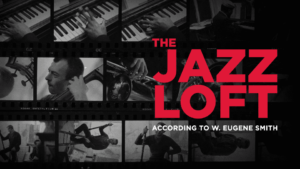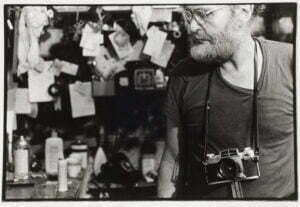The Jazz Loft According to W. Eugene Smith (2015)
Photographer W. Eugene Smith recorded 4000 hours of audio tape and took 40,000 photographs in the Jazz Loft between 1957 and 1965, now housed at the Center For Creative Photography at the University of Arizona.
Between 1957 and 1965 in New York, dozens of jazz musicians jam night after night in a dilapidated Sixth Avenue loft, not realizing that much of what they play and say to each other is being captured on audio tape and in still pictures by the gentle and unstable genius, former LIFE Magazine photographer W. Eugene Smith, who lives in the loft space next door.
Meanwhile, Thelonious Monk stops by for three weeks of rehearsals; drummer Ronnie Free gets hooked on hard drugs, having been turned on by a drummer who was his boyhood idol years before; loft-resident Hall Overton, Juilliard instructor and classical composer, becomes a jazz guru; the 50s give way to the 60s; Smith begins to record his own phone calls and visits from the local police; the world changes—and Smith gets evicted.

Smith applied his trademark obsessive perfectionism and artistic skills to documenting the sessions. Through a complex system of microphones, he recorded 4,000 hours of music while taking 40,000 photographs. These were all preserved, and now Sara Fishko has benefitted us immeasurably 60 years later by arranging this massive audio/visual stash into a quintessential fly-on-the-wall documentary, and in the process weaves several other discreet stories into the larger narrative.
Written, Produced, and Directed by Sara Fishko
Producer : Calvin Skaggs (Lumiere Productions)
Producer : Sam Stephenson
Editor : Jonathan J. Johnson
Director of Photography : Tom Hurwitz, ASC
WNYC Executive in Charge : Dean Cappello
Watch the film here.
Browse in the Library:
Sheet Music download here.
Photography is a small voice. It is an important voice in my life — but not the only one. I believe in it. If it is well conceived, it sometimes works.
— W. Eugene Smith
W. Eugene Smith (1918 – 1978) biography
Born and reared in Wichita, Kansas, W. Eugene Smith became interested in photography at the age of fourteen, and three years later had begun to photograph for local newspapers. He received a photography scholarship to the University of Notre Dame, but he left after a year for New York, where he joined the staff of Newsweek and freelanced for LIFE, Collier’s, Harper’s Bazaar, The New York Times, and other publications.
Beginning in 1939, Smith began working sporadically as a staff photographer for LIFE, with which he had a tempestuous relationship throughout the rest of his career. During World War II he was a war correspondent in the Pacific theater for the Ziff-Davis publishing company and LIFE, for whom he was working when he was severely wounded in Okinawa in 1945.
After a two-year recuperation, he returned to the magazine and produced many of his best photo essays, including “Country Doctor,” “Spanish Village,” and “A Man of Mercy.” In 1955, he joined Magnum, the international cooperative photography agency founded by Henri Cartier-Bresson, Robert Capa, George Rodger and Chim (David Seymour), and began work on a large photographic study of Pittsburgh, for which he received Guggenheim Fellowships in 1956 and 1957.
Smith continued to freelance for LIFE, Pageant, and Sports Illustrated, among other periodicals, for the rest of his career. From 1959 to 1977, he worked for Hitachi in Japan and taught at the New School for Social Research and the School of Visual Arts in New York and the University of Arizona in Tucson. His last photo essay, “Minamata,” completed in the 1970s, depicted victims of mercury poisoning in a Japanese fishing village.
Smith is credited with the developing the photo essay to its ultimate form.
He was an exacting printer, and the combination of innovation, integrity, and technical mastery in his photography made his work the standard by which photojournalism was measured for many years. In recognition of his outstanding contribution to the development of photojournalism, the W. Eugene Smith Memorial Fund was established after his death to support the projects of photographers working in the tradition he established.

